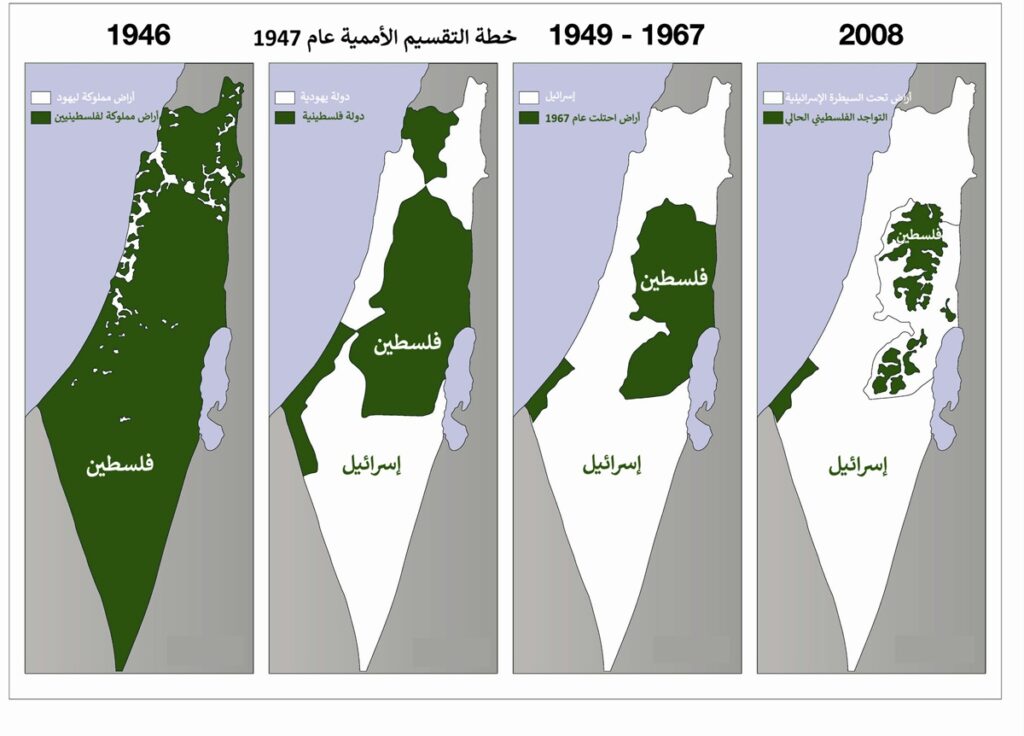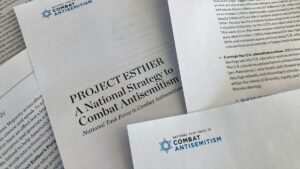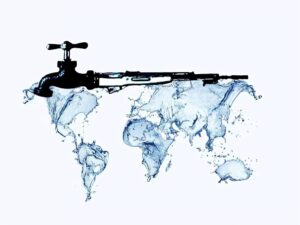Geopolitical challenges to the two-state solution in the Middle East in light of current changes

introduction
The Arab-Palestinian-Israeli conflict is one of the most complex geopolitical conflicts of the modern era, and has long been a subject of controversy among the various parties involved or concerned within the two camps of the conflict. On the Arab side, particularly the Palestinian side, there have been two camps: one pushing for a "settlement" of this conflict away from military means, and the other not believing in the possibility of achieving any solution without a culture of "resistance," including internationally guaranteed military resistance. In this analysis, we will not discuss the future of the conflict from the perspective of the "resistance camp," given that the Al-Aqsa Intifada is still ongoing, and therefore it is too early to discuss its direct impact on the conflict. Therefore, we will limit the discussion to the thinking of what can be called the "settlement camp," especially since it officially holds the decision-making power in the presence of the Palestinian Authority. The "two-state solution" has constituted the basic internationally agreed-upon theoretical framework for ending this conflict for decades. This article aims to provide an in-depth analysis of the prospects for achieving this solution in light of the current composition of the political balance of power in the United States, Israel, and the Palestinian Authority, as well as its Arab surroundings. The article will also examine some of the unprecedented implications of Operation Protective Edge for these opportunities, explore the most likely alternatives for implementation should the prospects for a two-state solution fade, and assess current diplomatic initiatives.
1. Evaluating the chances of a two-state solution in the context of the current balance of power
1.1. The Israeli reality: the erosion of political will and the rise of the right
An analysis of the Israeli political landscape reveals fundamental obstacles to the two-state solution. The most significant of these obstacles is the dominance of the extreme right in government, with the current Israeli government being the most right-wing in the country's history. This government, which includes figures and parties who explicitly reject the establishment of a Palestinian state and call for the annexation of parts of the West Bank, lacks the political will to advance the two-state solution.
In addition, The accelerating pace of settlement in the West Bank It systematically undermines the geographical foundations of any viable Palestinian state and impedes its territorial contiguity. This settlement expansion reflects the absence of a genuine “Israeli partner” willing to make the necessary concessions to end the occupation. Furthermore, Operation Protective Edge has led to an unprecedented escalation in The Israeli public mood is towards security tightening....and increased mistrust of any solutions that included concessions deemed security-related, significantly reducing any potential support for a two-state solution within Israeli society.
1.2. The American role: division and focus on regional priorities
Although the current US administration (the Biden administration) nominally supports the two-state solution, The deep partisan divide in the United States Focusing on other domestic and foreign issues (such as the conflict in Ukraine or competition with China) limits any US administration's ability to exert decisive pressure on Israel. In addition, The powerful influence of pro-Israel lobbies In Congress and the US administration, this makes it extremely difficult to enforce any US policy that directly conflicts with Israel's self-defined interests. Thus, the US role, despite its importance, remains constrained by internal and external factors that reduce its effectiveness in advancing the peace process.
1.3. The weakness of the Palestinian Authority and the Arab environment:
The Palestinian Authority suffers from Chronic internal weakness and erosion of popular legitimacy, in addition to deep internal divisions (especially between Fatah and Hamas), limiting their ability to negotiate effectively or implement any future agreements. On the Arab level, despite continued official support for a two-state solution, many Arab countries focused on their internal issues and regional challenges prior to the “Al-Aqsa Intifada,” reducing the potential for unified pressure on Israel and the United States. The repercussions of the “Al-Aqsa Intifada” have deepened polarization and weakened any chance of returning to serious negotiations in the foreseeable future, given the deteriorating humanitarian and political conditions.
2. The Arab-Palestinian vision for a two-state solution: challenges to achieving it
The Arab-Palestinian vision for a two-state solution clearly defines the following features: An independent Palestinian state on the June 4, 1967 borders, with limited land exchange, and East Jerusalem as the capital of PalestineWhen analyzing the chances of achieving this particular formula, it becomes clear that the obstacles increase significantly.
2.1. The 1967 borders and the settlement blocs:
A return to the June 4, 1967, borders is considered a red line for most of the Israeli political spectrum. Israel considers these borders “indefensible” from a security perspective and insists on retainingmajor settlement blocs Established in the West Bank and home to hundreds of thousands of settlers, evacuating these settlements is politically unthinkable in Israel, especially after October 7, when security tightening increased. While the Palestinian vision accepts a "limited" land swap, the Israeli vision of any swap tends to annex much larger areas, contradicting the principle of territorial contiguity of a Palestinian state.
2.2. The issue of East Jerusalem:
East Jerusalem is the most sensitive point of contention. Israel considers all of Jerusalem its "eternal and undivided capital" and rejects any division of the city or making East Jerusalem the capital of a Palestinian state. This position enjoys broad consensus within Israel and is reinforced by policies of de facto annexation and demographic change in East Jerusalem. Any talk of relinquishing East Jerusalem is completely off the table in current Israeli political discourse, making this Palestinian demand virtually impossible to achieve under current circumstances.
3. The most likely alternative: the “one-state solution” with a dual reality or permanent occupation.
In light of the enormous challenges facing the two-state solution, especially the Arab-Palestinian vision, a more feasible alternative emerges, which is: The continuation and deepening of Israeli control with limited and fragmented autonomy for the Palestinians, or what can be described as a “dual-reality one-state solution” or “permanent occupation.”“.
3.1. Features of this alternative:
- West Bank: Continued settlement expansion and complete Israeli control over most of the lands classified as Area C under the Oslo Accords.
- Gaza Strip: The Gaza Strip could become a permanently besieged area, with repeated Israeli military interventions and a catastrophic humanitarian situation. Israel may seek direct or indirect security control in the long term, and may even force the partial or complete depopulation of the Strip through pressure and displacement.
- Palestinians in Israel: Their continued marginalization and oppression as a minority.
3.2. Reasons for preferring this alternative:
- Israeli right-wing will: This scenario is consistent with the vision of the Israeli right, which prefers complete control over the territories without granting the Palestinians full state rights.
- Weakness of international opposition: Despite criticism, there is no international consensus or real political will to impose a different solution on Israel or to impose effective sanctions.
- The repercussions of the Al-Aqsa flood: These events have increased Israel's tendency toward absolute security control and undermined any Palestinian ambition for sovereignty, making this alternative more realistic.
4. Diplomatic Initiatives: The Paris-Riyadh Conference as a Model
In light of this complex reality, questions are being raised about the motivations and outcomes of diplomatic initiatives, such as the international conference that France and Saudi Arabia are preparing to hold.
4.1. Motives for the initiative:
- Maintaining the theoretical framework: The initiative is an attempt to keep the "two-state solution" on the international agenda and prevent its complete demise, thereby avoiding a slide toward more disastrous solutions.
- diplomatic ambition: France seeks to assert its independent, multilateral diplomatic role, while Saudi Arabia seeks to strengthen its regional and international leadership in light of the repercussions of the "Al-Aqsa Intifada" and the need to link any future normalization with Israel to tangible progress on the Palestinian issue.
- regional stability: Both countries recognize that the Palestinian-Israeli conflict is a major source of instability, and that any attempt to reduce tension is essential.
4.2. Expected results:
The results are likely to be Modest in terms of achieving a comprehensive political breakthrough, but it may carry some limited symbolic and practical significance:
- symbolic reaffirmation: The “two-state solution” will be reaffirmed as the only option, but this will not necessarily translate into a change in the facts on the ground.
- Push for aid and reconstruction: The conference may make progress in mobilizing support for humanitarian aid to Gaza and reconstruction arrangements.
- Building consensus around “The Day After”“: Scenarios for a post-war Gaza situation may be discussed, but reaching an effective consensus remains difficult, given Israel's rejection of many of the proposals.
- Strengthening the Palestinian Authority: The conference may seek to enhance the legitimacy and role of the Palestinian Authority as a future partner.
- Lack of full effectiveness: The conference's impact will remain limited if Israel does not participate actively, and if the United States does not provide strong and tangible support for its outcomes.
This initiative can be described as: A genuine diplomatic effort in terms of intentions and motives, but it faces enormous challenges that may make its direct political results very limited., and thus it may later be viewed as a failure to achieve a comprehensive breakthrough, but it is not just a “public relations campaign” devoid of any substance.
conclusion
The analysis shows that the chances of achieving a two-state solution, particularly in the Arab-Palestinian format (a state along the 1967 borders with East Jerusalem as its capital), are virtually nonexistent given the current balance of political power in Israel, the impact of Operation Protective Edge, the role of the United States, and the weakness of the Palestinian Authority. The most likely reality is the continuation of a dual-deed “one-state solution” or permanent occupation, in which comprehensive Israeli control remains in place with limited Palestinian autonomy. While diplomatic initiatives such as the Paris-Riyadh conference seek to keep the political horizon open and provide humanitarian assistance, their ability to radically alter the course of the conflict appears extremely limited in the absence of genuine political will from the main actors. The fundamental question remains: How long can the international community continue to support a theoretical framework without the ability to translate it into concrete reality on the ground? This question points to the urgent need for a comprehensive reassessment of future diplomatic strategies.





